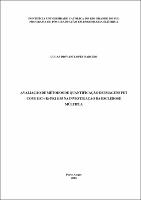| Share record |


|
Please use this identifier to cite or link to this item:
https://tede2.pucrs.br/tede2/handle/tede/7072| Document type: | Dissertação |
| Title: | Avaliação de métodos de quantificação de imagens PET com [11C]-(R)-PK11195 na investigação da esclerose múltipla |
| Other Titles: | Evaluation of [11C]-(R)-PK11195 PET images quantification methods in the study of multiple sclerosis |
| Author: | Narciso, Lucas Diovani Lopes  |
| Advisor: | Silva, Ana Maria Marques da |
| Abstract (native): | A ativação da micróglia é uma resposta importante a processos inflamatórios no sistema nervoso central (SNC). Estudos vêm utilizando a aquisição de imagens de tomografia por emissão de pósitrons (PET) com o radiotraçador [11C]-(R)-PK11195, ligante seletivo para TSPO, presente em níveis baixos no SNC saudável. Embora a literatura traga diversos métodos quantitativos de análise das imagens de PET cerebrais adquiridas com [11C]-(R)-PK11195, não existe método padronizado de análise aplicável na prática clínica. Limitações envolvem a necessidade de amostragem de sangue arterial para aquisição da função de entrada para quantificação verdadeira de parâmetros cinéticos, tais como o potencial de ligação. Quando a função de entrada arterial não é adquirida, a utilização de modelos baseados em região de referência apresenta erros de quantificação, pois não existe uma região no cérebro que seja livre de ligação específica de [11C]-(R)-PK11195. O objetivo desse trabalho é investigar métodos de análise quantitativa e semiquantitativa de imagens de PET cerebrais adquiridas com [11C]-(R)-PK11195, identificando suas limitações e potencialidades. Esse trabalho está inserido dentro de um estudo clínico com pacientes com esclerose múltipla (EM) do tipo remitente-recorrente em tratamento com fingolimode. Serão utilizadas imagens cerebrais de PET adquiridas com [11C]-(R)-PK11195 e imagens estruturais de ressonância magnética ponderadas em T1. Métodos de análise quantitativa e semiquantitativa serão comparadas, levando em consideração aspectos específicos da EM. Na análise transversal, o uso do SUVRWM na região justacortical e periventricular apresenta os melhores resultados de diferenciação entre grupos de pacientes com EM e o grupo controle. Na análise longitudinal, o uso do SUVRWM e do SUVRCB podem indicar o comportamento da captação de [11C]-(R)-PK11195 ao longo do tempo, sendo tais medidas potenciais indicadores de evolução da EM quando aplicados nas regiões justacortical e periventricular. Conclui-se que, dentre os métodos analisados, o método SUVRWM apresenta resultados promissores e satisfatórios, em especial quando aplicado às regiões justacortical e periventricular. |
| Abstract (english): | The activation of microglia is an important response to inflammatory processes in the central nervous system (CNS). There has been an increase in the number of researches in positron emission tomography (PET) using the radiotracer [11C]-(R)-PK11195, a selective ligand for TSPO, present at low levels in the healthy CNS. Although the literature brings many quantitative methods to analyze [11C]-(R)-PK11195 PET brain images, there is no standardized method of analysis applicable in clinical practice. Limitations involve the need for arterial blood sampling for the input function acquisition, aiming absolute quantification of kinetic parameters, such as the binding potential. When the arterial input function is not acquired, the use of models based on a reference region has quantification errors, since there is no brain region free of [11C]-(R)-PK11195 specific binding. The aim of this study is to investigate methods of quantitative and semiquantitative analysis of [11C]-(R)-PK11195 PET brain images, identifying limitations and capabilities. This work is inserted into a clinical study of patients with relapsing-remitting multiple sclerosis (MS) in treatment with fingolimod. There will be used [11C]-(R)-PK11195 PET brain images and structural T1-weighted magnetic resonance images. Methods of quantitative and semiquantitative analyzes will be compared, taking into consideration the specific aspects of MS. In the cross-sectional analysis, the use of SUVRWM in juxtacortical and periventricular regions presented the best results in differentiate between groups of patients with MS and the healthy control group. In the longitudinal analysis, the use of SUVRWM and SUVRCB may indicate the [11C]-(R)-PK11195 uptake behavior over time, and such measurements may be potential indicators of MS evolution when applied in the juxtacortical and periventricular regions. In conclusion, among the methods analyzed, SUVRWM method shows promising and satisfactory results, especially when applied to juxtacortical and periventricular regions. |
| Keywords: | ESCLEROSE MÚLTIPLA TOMOGRAFIA POR EMISSÃO DE PÓSITRONS NEUROIMAGEM NEUROFISIOLOGIA ENGENHARIA BIOMÉDICA |
| CNPQ Knowledge Areas: | ENGENHARIAS |
| Language: | por |
| Country: | Brasil |
| Publisher: | Pontifícia Universidade Católica do Rio Grande do Sul |
| Institution Acronym: | PUCRS |
| Department: | Faculdade de Engenharia |
| Program: | Programa de Pós-Graduação em Engenharia Elétrica |
| Access type: | Acesso Aberto |
| URI: | http://tede2.pucrs.br/tede2/handle/tede/7072 |
| Issue Date: | 31-Aug-2016 |
| Appears in Collections: | Programa de Pós-Graduação em Engenharia Elétrica |
Files in This Item:
| File | Description | Size | Format | |
|---|---|---|---|---|
| DIS_LUCAS_DIOVANI_LOPES_NARCISO_COMPLETO.pdf | Texto Completo | 3.16 MB | Adobe PDF |  Download/Open Preview |
Items in DSpace are protected by copyright, with all rights reserved, unless otherwise indicated.




